
Ribbon Shootout: Drum Overheads
Friday, July 22nd, 2011 | by matthew mcglynn
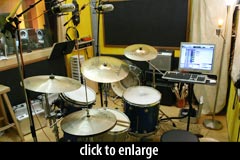 The drum session of the $60,000 Ribbon Microphone Shootout was recorded at Jon Mattox’ Bright Orange Studios in Los Angeles. Jon is a musician and producer whose compositions have been used on enough Hollywood movie trailers that I can pretty much guarantee that you’ve heard his stuff before.
The drum session of the $60,000 Ribbon Microphone Shootout was recorded at Jon Mattox’ Bright Orange Studios in Los Angeles. Jon is a musician and producer whose compositions have been used on enough Hollywood movie trailers that I can pretty much guarantee that you’ve heard his stuff before.
(If you are interested in drum microphones, you should check out Jon’s reviews of the JZ DMK1 and the new Shure Beta kit.)
Jon was fully on the hook for this session. He not only hosted it, he also performed and drove Pro Tools at the same time. Randy Coppinger and myself were on hand to swap mics, curse at mic stands, and eat pizza while Jon did most of the work.
Microphone Positioning
I know of no engineer more educated on matters of stereo recording than Randy Coppinger. He explains our positioning choice here:
Randy Coppinger
When placing a pair of microphones to create a stereo soundfield, I think about these two factors:
- If a sound is louder in one speaker than another, it will seem to be located in the louder direction.
- If a sound is delayed in one speaker as compared to the other, it will seem to be located in the earlier direction.
Microphones can be in a “Coincident” array, where they are so close to each other they are virtually on the same plane, with the mics’ axes angled to create stereo (X/Y, Mid-Side, Blumlein). The stereo effect here is created by level difference, not time difference.
Or, they can be in an A/B or “Spaced” array. This creates timing and some level differences.
If the microphones in the A/B array are angled outward, the result is a convincing, combined stereo effect with both timing and significant level differences.
But if you take a pair of cardioid microphones, put some space in between them and angle the microphones inward, toward the sound source, you can create mis-cues for the listener’s ears. If you point microphones inward, it is possible to have a sound source actually located to the left be softer in volume in the left channel, but arrive earlier. This conflict confuses the stereo image. That doesn’t mean it can’t sound fantastic, but it may impair a listener’s ability to localize a sound in a realistic way. For this reason, most professionals prefer their spaced-pair stereo microphones angled outward.
What if we had angled the ribbon mikes outward in our our drum overhead shootout? With a figure-8 polar pattern, the back side of the mic is as sensitive as the front. So if the drum sound spreads out into the room and is reflected back into the rear of the opposite-side mic with sufficient volume, you might hear the right side room reflections in the left channel. Flipping the room reflections around in this way is not as egregious as creating timing/level cue conflicts in the direct sound, but I prefer to avoid it. That is why I recommended we use an A/B array, with no angle between the microphones.
In the end, both overhead mics were 66'' from the floor, 17'' apart, and 36'' each from the center of the snare drum, pointing straight up and down. We kept the mics close together to avoid having a hole in the middle of the perceived stereo field; at higher distances, more space between the mics would be feasible.
Test Setup and Signal Path
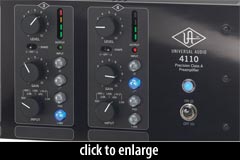 All the mics, active and passive, were run through Jon’s UA 4410 preamp, with the “Shape” switch set to Modern (disabling the transformers). As usual we wanted the cleanest, most pure signal path possible so that the color differences of the microphones would come through. Jon’s converters are Panasonic WZ-96AD, with a Mytek 192cx master clock.
All the mics, active and passive, were run through Jon’s UA 4410 preamp, with the “Shape” switch set to Modern (disabling the transformers). As usual we wanted the cleanest, most pure signal path possible so that the color differences of the microphones would come through. Jon’s converters are Panasonic WZ-96AD, with a Mytek 192cx master clock.
We recorded into Pro Tools at 24-bit, 48 kHz.
The Stand Lament
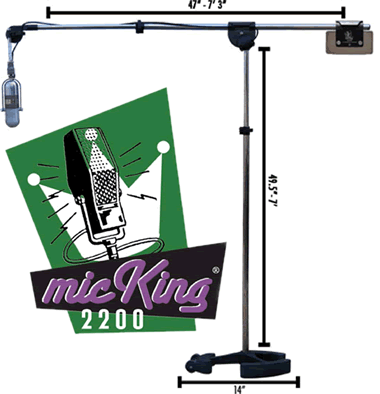 Perhaps only drummer/engineers know what an enormous pain in the ass it is to hang a heavy microphone over a drum kit when the stand has to be way on the other side of the ride cymbal, floor tom, kick drum, etc. Cantilevering even a medium-weight microphone like this will nuke most cheap mic stands. The clutch on nearly every stand I own, frankly, sucks.
Perhaps only drummer/engineers know what an enormous pain in the ass it is to hang a heavy microphone over a drum kit when the stand has to be way on the other side of the ride cymbal, floor tom, kick drum, etc. Cantilevering even a medium-weight microphone like this will nuke most cheap mic stands. The clutch on nearly every stand I own, frankly, sucks.
The refrain after every take in Jon’s studio was “Why oh why have we not bought any Latch Lake stands?”
If you ever hang mics over a drum kit, you should have at least one of these things. And avoid using AB arrays until you can afford a second one.
(I usually do Recorderman or ORTF, which lets me get away with cheap mic stands behind the kit. 🙂 But I’m still saving up for a Mic King 2200. Or, rather, a pair.)
Why so few mics?!
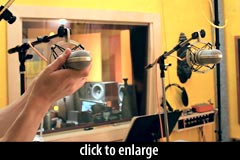 I admit it. We had nine pairs of mics, and I’m feeling like, that’s it? Oh, so very jaded I have become.
I admit it. We had nine pairs of mics, and I’m feeling like, that’s it? Oh, so very jaded I have become.
In truth we never attempted, nor wanted to have pairs of every microphone. But we tried to get pairs of all the mics we thought would be best for drum overheads — the most suitable model from each vendor.
Could we have recorded mono overheads with the full set of 30 ribbon mics in this shootout? Sure, but I really really really really really hate mono drum overheads. So much so, that I didn’t even bring single mics to Jon’s studio.
This session does not include a few pairs we expected to use:
- The Sontronics Sigma pair overloaded in this position. (Hear them in the followup session, below.)
- The Blue Woodpecker pair was skipped because one of the mics was distorting (electronic clipping) during the guitar cab test.
- The Coles 4050 would have been great here. We didn’t hang them because I thought we had only one mount. Alas, the second mount was there, but we found it too late.
No shortage of high end
Forget any beliefs you might have of ribbon microphones being too dark for use as drum overheads. If all you’ve ever heard are cheap, tizzy condensers, then your ears will need to adjust. But they’ll thank you for it.
And remember that ribbons take EQ really well. Here’s an explanation why:
Royer Labs
If you do need to EQ your tracks, no other kind of microphone stands up as well to EQ as a ribbon. They take EQ so well because of their natural frequency response and lack of distortion artifacts: there’s no “junk” to bring up with the signal — just the music!
The tracks below were recorded and output with no EQ, but I recommend downloading the full session files so you can play with the EQ on the original 24-bit, 48-kHz tracks. Certainly before you dismiss any of these tracks for not sounding the way condenser OH tracks do, grab the session and add a high shelf EQ, and I wager you’ll hear what you’re missing. (And you’ll probably be putting your cheap OH condensers up on Ebay shortly thereafter.)
The other cool thing about having the full session is that it’s really easy to select a short sequence and solo each of the tracks within that loop, like so:
Looped drum fill
We didn’t record a condenser pair during the ribbon test, but just to give you an idea of what the drums and the room sound like, here’s Jon playing through a pair of vintage AKG C 451 SDCs:
Condenser Pair
Audio Files
These files were gain-matched in Pro Tools, then output as 24/48 WAVs and converted to 320kbps stereo MP3s via lame. Because the preamps were the same for all mics, I haven’t separated active from passive.
Listening Notes
The  Cascade Fat Head IIs are the darkest pair of the bunch. They have a thick, heavy, almost compressed-sounding midrange that makes me think they’d be great as room mics. They open up with EQ, but not as much as some of the others.
Cascade Fat Head IIs are the darkest pair of the bunch. They have a thick, heavy, almost compressed-sounding midrange that makes me think they’d be great as room mics. They open up with EQ, but not as much as some of the others.
The  Royer R-122s are the least hyped, least colored pair. Every time I hear them I think of the word “honest.” No frequencies poke out at me. These have an even, balanced sound. And the low-end response is killing — listen to the kick drum!
Royer R-122s are the least hyped, least colored pair. Every time I hear them I think of the word “honest.” No frequencies poke out at me. These have an even, balanced sound. And the low-end response is killing — listen to the kick drum!
The  sE RNR1s sound open, natural, and balanced too. They seems to hear more of the room than do the Royers. I would have no complaints about using these.
sE RNR1s sound open, natural, and balanced too. They seems to hear more of the room than do the Royers. I would have no complaints about using these.
The  Audio-Technica AT4080 pair sounds nice and solid here. These mics are brighter than the RNR1 and R-122, in a good way. And they still take EQ well.
Audio-Technica AT4080 pair sounds nice and solid here. These mics are brighter than the RNR1 and R-122, in a good way. And they still take EQ well.
The  Cloud JRS-34s sound really good here too — neutral, clean, and well-balanced. They are a little softer on the top than the R-122s, maybe a little veiled overall, but the track has a great vintage vibe.
Cloud JRS-34s sound really good here too — neutral, clean, and well-balanced. They are a little softer on the top than the R-122s, maybe a little veiled overall, but the track has a great vintage vibe.
The  Shure KSM353 pair is really interesting. They’re the most controlled sound here, with an inorganic quality that makes me think they’d be great for pop music. There’s almost a scooped EQ happening with these; I hear highs and lows, but not so much mid. The toms don’t ring. There’s almost a gated quality to the sound. It’s a cool effect, definitely useful in some contexts, but it doesn’t communicate the sense of the space as well as the other microphones here.
Shure KSM353 pair is really interesting. They’re the most controlled sound here, with an inorganic quality that makes me think they’d be great for pop music. There’s almost a scooped EQ happening with these; I hear highs and lows, but not so much mid. The toms don’t ring. There’s almost a gated quality to the sound. It’s a cool effect, definitely useful in some contexts, but it doesn’t communicate the sense of the space as well as the other microphones here.
The  Cascade VIN-JET turns in an impressive performance. The kick drum in the opening phrase is huge and deep, and the hi-hats are really high. It’s like someone added an octave to each end of the frequency response of the Fathead. The toms sound big. The snare sounds good. This is a great sound.
Cascade VIN-JET turns in an impressive performance. The kick drum in the opening phrase is huge and deep, and the hi-hats are really high. It’s like someone added an octave to each end of the frequency response of the Fathead. The toms sound big. The snare sounds good. This is a great sound.
The  Shinybox 46U is another strong contender. It has less boost in the frequency of the hi-hats (4kHz?) than does the VinJet, despite having what I think is a generally brighter response. The cymbals sound great. The kick drum is every bit as low and deep as on the VinJet. Maybe even a tiny bit deeper?
Shinybox 46U is another strong contender. It has less boost in the frequency of the hi-hats (4kHz?) than does the VinJet, despite having what I think is a generally brighter response. The cymbals sound great. The kick drum is every bit as low and deep as on the VinJet. Maybe even a tiny bit deeper?
Finally, we have the  Samar Audio Design MF65. These mics have a unique ability to capture transients. Loop the tom fills and compare to the other mics; the MF65s captured more of the aggressive slap of stick on head. It’s an effect that takes me out of the control room and puts me on the drum throne. (Neat trick for a microphone!)
Samar Audio Design MF65. These mics have a unique ability to capture transients. Loop the tom fills and compare to the other mics; the MF65s captured more of the aggressive slap of stick on head. It’s an effect that takes me out of the control room and puts me on the drum throne. (Neat trick for a microphone!)
I thought I would have a clear favorite pair after this test, but all these mics sounded really good, albeit in different ways. If you need to record drum overheads, none of these would hold you back. Choosing one is more a matter of color selection.
Second Session
One of the challenges of these shootouts is that making comparisons across mics requires that all the mics be treated identically: same preamps, same gain staging, same position and distance from the source. But of course, some mics would work better if they’re placed somewhere else.
That’s not a practical methodology for any large-scale test like this, and further, the subjective nature of such placement makes the results much less useful.
Nonetheless, I really wanted to hear the Sigma. To that end, I set up a second, abbreviated drum session.
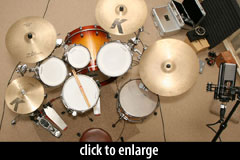 I knew the Sigmas would need to be further from the drums than we’d had them at Jon’s studio. But that meant I needed a room with a higher ceiling. So I moved the drums to a different room, and I hung the microphones 80'' off the ground, about 44'' apart, and 59'' from the center of the snare drum. The mics were in an AB array, behind the drums and angled toward them; a line drawn between the mics would bisect the throne.
I knew the Sigmas would need to be further from the drums than we’d had them at Jon’s studio. But that meant I needed a room with a higher ceiling. So I moved the drums to a different room, and I hung the microphones 80'' off the ground, about 44'' apart, and 59'' from the center of the snare drum. The mics were in an AB array, behind the drums and angled toward them; a line drawn between the mics would bisect the throne.
The Sigmas’ output was still too hot for the preamps on my DAW; at minimum gain, the tracks in Pro Tools were clipping. So, for the active mics in this test, I used my backup neutral pre’s, the Presonus Digimax FS. For the passive mics, I used the higher-gain pre’s in my BLA Digi 002.
The point of this second round was simply to give the Sigmas some context, so I did not attempt to track every mic in the locker. I included a few of the other ribbons, plus a pair of SDCs.
Mic: Oktava MK-012 – my go-to OH SDCs
– my go-to OH SDCs
Mic: Sontronics Sigma
Mic: Cascade Microphones VIN-JET
Mic: Shure KSM353
Listening Notes
It must be said: these clips clearly illustrate the proximity effect in the all the mics from the first session.
My favorites in this followup test are the VinJet, the AT4080, and the KSM353. The VJ and 4080 have fat, punchy, deep lows, and both make my go-to OH condensers sound brash*. I think I’d give the AT4080 the edge over the VinJet for transient response; the toms have more snap.
The KSM353 captures the crack of the snare in a really convincing way; it has an undeniable presence that makes the drums cut really well — even if its low-frequency rolloff is much higher than the VinJet and AT4080. (For an overhead mic, that is not a bad thing, assuming big toms and the kick drum are close-miked.)
By the way, the low-frequency extension of the AT4080 and VinJet suggests that they’d be great room mics.
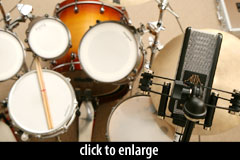 The Sigmas capture what I think of as a vintage sound. Transients are softer and rounder, and the track has a more ambient sound. There is a bloom in the low mids; it makes the kick drum sound warm and full, maybe at the expense of overall clarity and punch. Compare to the KSM353, which is almost scooped in this frequency range.
The Sigmas capture what I think of as a vintage sound. Transients are softer and rounder, and the track has a more ambient sound. There is a bloom in the low mids; it makes the kick drum sound warm and full, maybe at the expense of overall clarity and punch. Compare to the KSM353, which is almost scooped in this frequency range.
I know the Sigma has been used as the OH mic on some popular drum sample libraries, so I am relieved that I finally got to hear it above a drum kit. The mic’s high sensitivity makes it usable for a lot of applications where passive ribbon mics (or, more accurately, their downstream preamps) would struggle — specifically, quiet acoustic or distant sources — but for a loud drum kit these mics have a smaller “sweet spot” than the other ribbons I tried. I’d love to see a “Sigma II” with a built-in pad; the additional headroom would make the mic more versatile for loud sources.
*Wait, did I say that out loud?
My go-to overhead mics sound “brash” ?!
Well, if I ever put AB overheads 80'' high again, I sure won’t reach for condensers; the natural brightness of these mics doesn’t do any favors to the sound of the snare buzz and the cymbals in this room. At my normal OH height (32 inches), these mics are hard to beat. It’s a good reminder of everything we already know about miking drums — namely that mic height and position significantly affect the relative volumes of cymbals, drums, and room.
Grab the sessions
 The raw 24-bit, 48 kHz audio from both drum sessions can be downloaded here.
The raw 24-bit, 48 kHz audio from both drum sessions can be downloaded here.
But wait, there’s more…
Other stories from this series:
- Introduction to the $60k Ribbon Mic Shootout
- List of Ribbon Microphones Tested
- Guitar Cab Session 1: Fender
- Guitar Cab Session 2: Marshall
- Drum Overhead Sessions (YOU ARE HERE)
- Saxophone Session
- Voiceover Session
- Acoustic Guitar Session
- 24-bit audio file archive
- Wrap-up and Conclusions
Posted in Drums, Microphones, Reviews, Shootouts, Technique | 17 Comments »

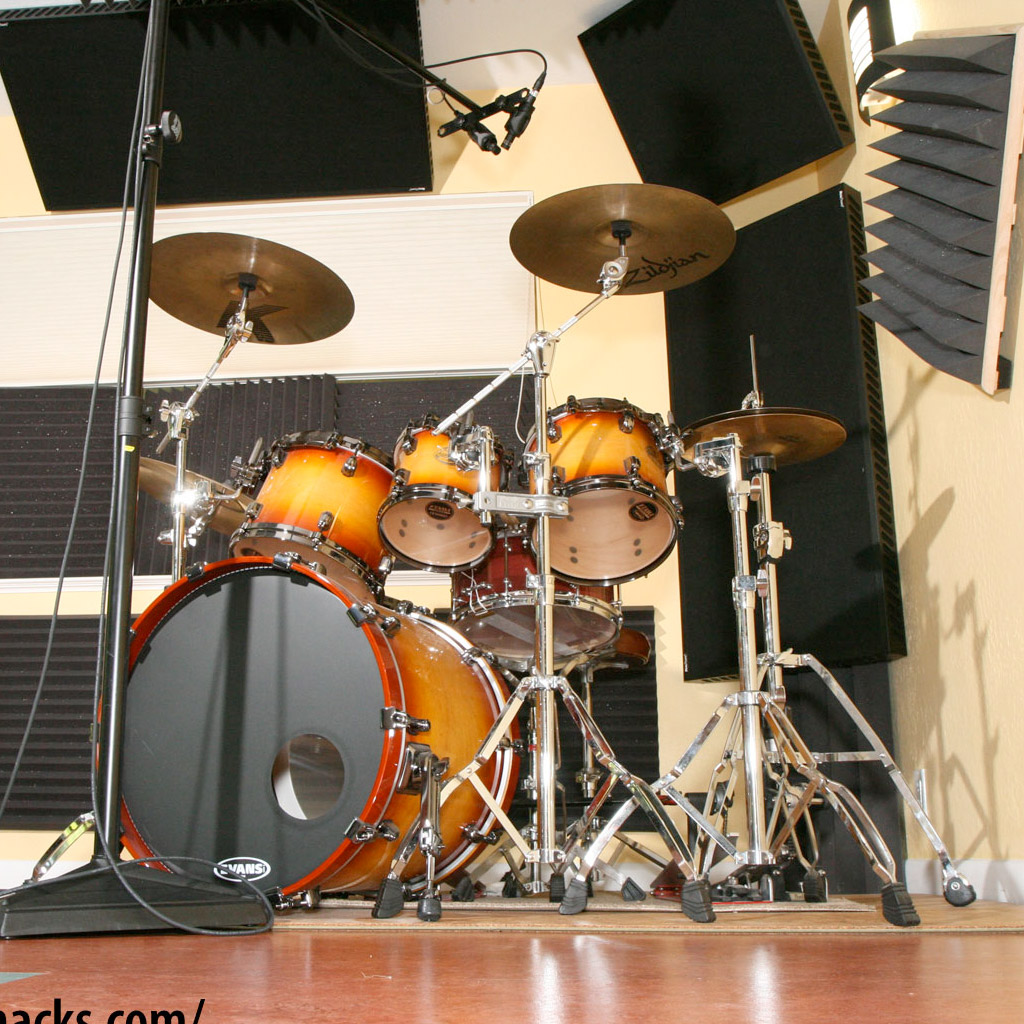
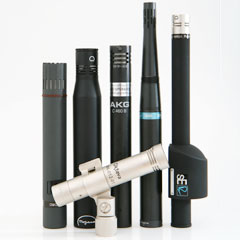

Mark Chierego
July 25th, 2011 at 4:26 am
Wow that Samar mic is really 3d !! When compared to the Royer and most of the other .
It’s detail city!
I think it might be down to a well made 1.8 micron ribbon and acustically transparent design?
I only say this because I hear similar results when I compair my fully modded Lundahl tranny,1.8 micron, fathead syle/Lollipop ribbon mics with the Royer 121 which has a 2.5 micron ribbon.
I have a shootout on the main page of my blog if anyone is interested in listening.
Great work again guys!!
Ryan Canestro
July 25th, 2011 at 9:00 pm
I just listened tonight with fresh ears and some distance from the tracking of all of these microphones. My top 3 from this shootout are the Vin-Jets, Samar Audio, and Shiny Box. They gave the best top end and overall balance that I would look for in overheads.
william
July 26th, 2011 at 4:11 am
oh yeah for less than 400$ a pair vin jets are great on drums.
matthew mcglynn
July 26th, 2011 at 7:13 am
@william – the Vin Jets we used had Lundahl transformers, at a cost of $349 apiece ($700 for the pair).
Dima Zaytsev
July 26th, 2011 at 1:02 pm
Oh thanks for this sounds… Seems like ribbon mics on OH never be my style. Still waitin for my favorite pair of JZ mics (Thanks to Jon for review)
Nick Zimmerman
July 27th, 2011 at 2:06 pm
On the Fat Head II and the Vin-Jet were they stock, or did they have any transformer upgrades from Cascade?
matthew mcglynn
July 27th, 2011 at 2:22 pm
@nick, both the Cascade pairs had Lundahl transformers. See notes about the lineup here: http://recordinghacks.com/2011/07/13/too-many-ribbon-mics/
Nick Zimmerman
July 27th, 2011 at 6:01 pm
@ Matt. I figured the info had to be in here somewhere, I just couldn’t find it. Thanks for the easy link.
Sam
August 11th, 2011 at 6:41 pm
Love those Samar mics sound! I wish they were already for sale. The VIN Jet have a great sound too. Strongly considering buying them to do some cello recording. Thanks for all the hard work on this shootout guys!
Robby Baxter
September 20th, 2011 at 2:14 am
Thanks guys!
Very helpful !!!!
Igor
January 13th, 2012 at 11:08 am
Wow. You’re some kind of drum miking fascist.
I guess I’d better go through my record collection and throw out all the old Jerry Lee Lewis, Tommy Dorsey, Howlin’ Wolf, and David Bowie since the drums were recorded in mono.
matthew mcglynn
January 13th, 2012 at 11:33 am
@Igor, actually I’m a stereo drum miking facist. 🙂
zumbi
February 12th, 2012 at 3:16 pm
excellent report, very informative as the rest of your site that i recently discovered.
in the blind test you could put numbers next to the files:
it becomes hard to remember which was the last one played or to take note…
and yes there’s plenty of wonderful example of mono drum recordings:
don’t be a stereofascist 😉
Allan
May 27th, 2012 at 9:05 pm
Very informative guy’s great job. I like the sound of the fathead’s might have to look into them. The price is right. Thanks
vintagelover
September 23rd, 2015 at 3:53 pm
such a shame that there are no coles 4038’s on overheads,
many people’s go to oh’s
Pascal
May 2nd, 2017 at 12:59 am
Excellent work again – thanks!
The Samars have that very classy and balanced sound that I’m leaning towards.
Pascal
May 2nd, 2017 at 1:01 am
On the 2nd test, the KSM has a snap that makes me smile right away!